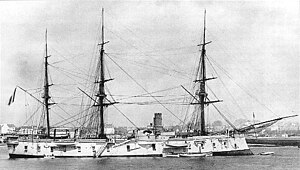La Galissonnière-class ironclad

La Galissonnière in 1885
|
|
| Class overview | |
|---|---|
| Name: | La Galissonnière class |
| Operators: |
|
| Preceded by: | Alma class |
| Succeeded by: | Bayard class |
| Subclasses: | Victorieuse and Triomphante |
| Built: | 1868–1880 |
| In service: | 1874–1900 |
| Completed: | 3 |
| Scrapped: | 3 |
| General characteristics (La Galissonnière) | |
| Type: | Ironclad |
| Displacement: | 4,654 metric tons (4,580 long tons) |
| Length: | 76.62 m (251 ft 5 in) |
| Beam: | 14.84 m (48 ft 8 in) |
| Draft: | 6.55 m (21.5 ft) (mean) |
| Installed power: | |
| Propulsion: | 2 shafts, 2 vertical compound steam engines |
| Sail plan: | Ship rig |
| Speed: | 12 knots (22 km/h; 14 mph) |
| Range: | 2,920 nautical miles (5,410 km; 3,360 mi) at 10 knots (19 km/h; 12 mph) |
| Complement: | 352–382 |
| Armament: |
|
| Armor: | |
The La Galissonnière-class ironclads were a group of wooden-hulled, armored corvettes built for the French Navy during the 1870s, meant as a heavier armed and faster version of the Alma-class ironclads. While all three ships were begun before the Franco-Prussian War of 1870–71, the construction of the last two ships was delayed for years. The navy took advantage of the extended construction time of the latter ships to upgrade their armament. La Galissonnière bombarded Sfax in 1881 as part of the French occupation of Tunisia. She and her half-sister Triomphante participated in a number of battles during the Sino-French War of 1884–85. Their sister Victorieuse had a much quieter career. All three ships were decommissioned in the 1890s.
The La Galissonnière-class ironclads were designed as faster, more heavily armed versions of the Alma-class ironclads by Henri Dupuy de Lôme. They used the same central battery layout as their predecessors, although the battery was lengthened 4 meters (13 ft 1 in) to provide enough room to work the larger 240-millimeter (9.4 in) guns. A two-propeller layout was adopted in an unsuccessful attempt to reduce the ship's draft. The two later ships were designed by Sabattier who reduced the number of screws from two to one to improve their sailing qualities, added an 194-millimeter (7.6 in) bow chaser under the forecastle and increased the caliber of the secondary armament.
...
Wikipedia
